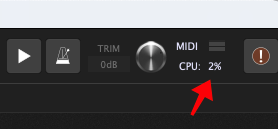Here’s my latest result:
CONCLUSION
Your system seems to be having difficulty handling real-time audio and other tasks. You may experience drop outs, clicks or pops due to buffer underruns. One problem may be related to power management, disable CPU throttling settings in Control Panel and BIOS setup. Check for BIOS updates.
LatencyMon has been analyzing your system for 13:31:28 (h:mm:ss) on all processors.
SYSTEM INFORMATION
Computer name: TABLET-N9UQINOA
OS version: Windows 10, 10.0, version 2009, build: 19042 (x64)
Hardware: Surface Pro 7, Microsoft Corporation
CPU: GenuineIntel Intel(R) Core™ i7-1065G7 CPU @ 1.30GHz
Logical processors: 4
Processor groups: 1
RAM: 15970 MB total
CPU SPEED
Reported CPU speed: 1498 MHz
Note: reported execution times may be calculated based on a fixed reported CPU speed. Disable variable speed settings like Intel Speed Step and AMD Cool N Quiet in the BIOS setup for more accurate results.
MEASURED INTERRUPT TO USER PROCESS LATENCIES
The interrupt to process latency reflects the measured interval that a usermode process needed to respond to a hardware request from the moment the interrupt service routine started execution. This includes the scheduling and execution of a DPC routine, the signaling of an event and the waking up of a usermode thread from an idle wait state in response to that event.
Highest measured interrupt to process latency (µs): 1103.40
Average measured interrupt to process latency (µs): 10.312128
Highest measured interrupt to DPC latency (µs): 1028.50
Average measured interrupt to DPC latency (µs): 3.089149
REPORTED ISRs
Interrupt service routines are routines installed by the OS and device drivers that execute in response to a hardware interrupt signal.
Highest ISR routine execution time (µs): 110.257009
Driver with highest ISR routine execution time: Wdf01000.sys - Kernel Mode Driver Framework Runtime, Microsoft Corporation
Highest reported total ISR routine time (%): 0.000519
Driver with highest ISR total time: Wdf01000.sys - Kernel Mode Driver Framework Runtime, Microsoft Corporation
Total time spent in ISRs (%) 0.000519
ISR count (execution time <250 µs): 106114
ISR count (execution time 250-500 µs): 0
ISR count (execution time 500-1000 µs): 0
ISR count (execution time 1000-2000 µs): 0
ISR count (execution time 2000-4000 µs): 0
ISR count (execution time >=4000 µs): 0
REPORTED DPCs
DPC routines are part of the interrupt servicing dispatch mechanism and disable the possibility for a process to utilize the CPU while it is interrupted until the DPC has finished execution.
Highest DPC routine execution time (µs): 698.120828
Driver with highest DPC routine execution time: ACPI.sys - ACPI Driver for NT, Microsoft Corporation
Highest reported total DPC routine time (%): 0.031416
Driver with highest DPC total execution time: rspLLL64.sys - Resplendence Latency Monitoring and Auxiliary Kernel Library, Resplendence Software Projects Sp.
Total time spent in DPCs (%) 0.092686
DPC count (execution time <250 µs): 17708696
DPC count (execution time 250-500 µs): 0
DPC count (execution time 500-10000 µs): 35128
DPC count (execution time 1000-2000 µs): 0
DPC count (execution time 2000-4000 µs): 0
DPC count (execution time >=4000 µs): 0
REPORTED HARD PAGEFAULTS
Hard pagefaults are events that get triggered by making use of virtual memory that is not resident in RAM but backed by a memory mapped file on disk. The process of resolving the hard pagefault requires reading in the memory from disk while the process is interrupted and blocked from execution.
NOTE: some processes were hit by hard pagefaults. If these were programs producing audio, they are likely to interrupt the audio stream resulting in dropouts, clicks and pops. Check the Processes tab to see which programs were hit.
Process with highest pagefault count: system
Total number of hard pagefaults 6905
Hard pagefault count of hardest hit process: 2420
Number of processes hit: 22
PER CPU DATA
CPU 0 Interrupt cycle time (s): 615.216649
CPU 0 ISR highest execution time (µs): 110.257009
CPU 0 ISR total execution time (s): 1.011295
CPU 0 ISR count: 106114
CPU 0 DPC highest execution time (µs): 623.277036
CPU 0 DPC total execution time (s): 138.303991
CPU 0 DPC count: 15403163
CPU 1 Interrupt cycle time (s): 413.510975
CPU 1 ISR highest execution time (µs): 0.0
CPU 1 ISR total execution time (s): 0.0
CPU 1 ISR count: 0
CPU 1 DPC highest execution time (µs): 644.176903
CPU 1 DPC total execution time (s): 15.441697
CPU 1 DPC count: 1163006
CPU 2 Interrupt cycle time (s): 243.954067
CPU 2 ISR highest execution time (µs): 0.0
CPU 2 ISR total execution time (s): 0.0
CPU 2 ISR count: 0
CPU 2 DPC highest execution time (µs): 605.834446
CPU 2 DPC total execution time (s): 6.571032
CPU 2 DPC count: 413783
CPU 3 Interrupt cycle time (s): 297.130660
CPU 3 ISR highest execution time (µs): 0.0
CPU 3 ISR total execution time (s): 0.0
CPU 3 ISR count: 0
CPU 3 DPC highest execution time (µs): 698.120828
CPU 3 DPC total execution time (s): 20.191093
CPU 3 DPC count: 763872
